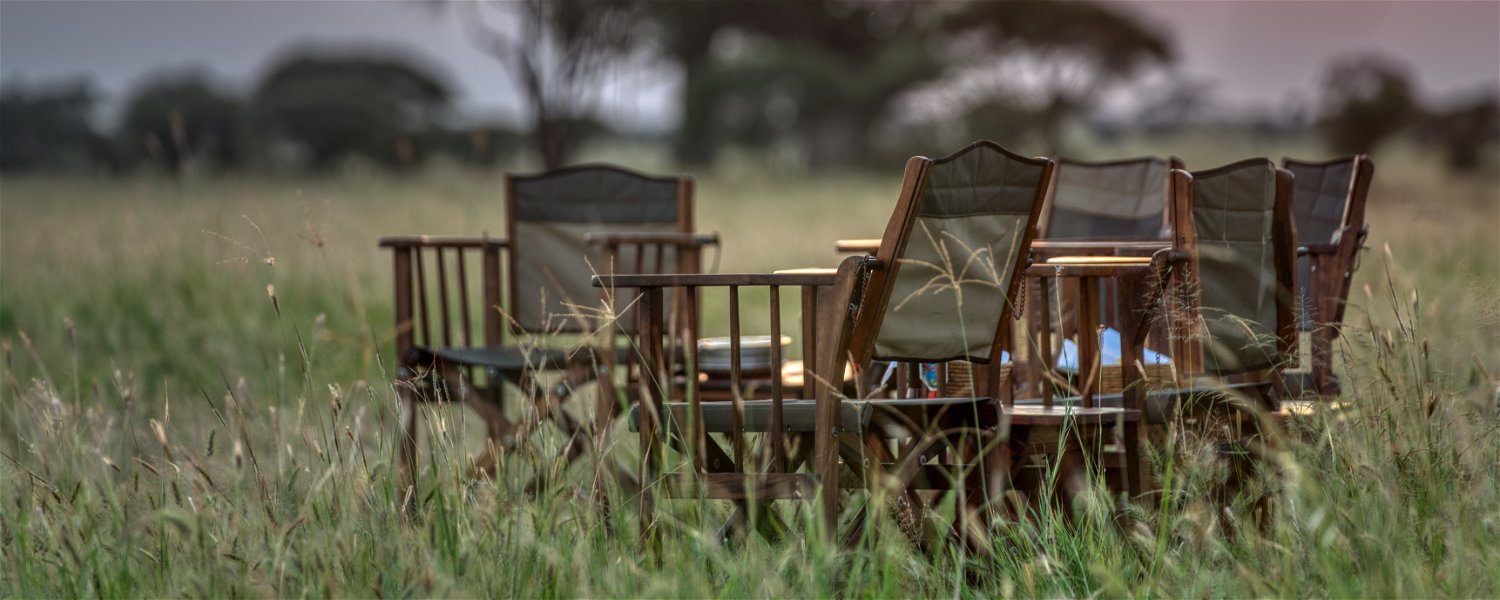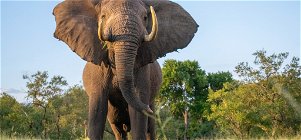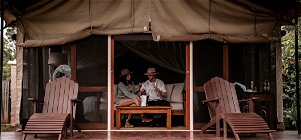The Story of Honeyguide told by our founder, Soren Rasmussen
 My first safaris in Africa were extremely primitive. Overnight accommodations were a mattress pad in a little tent and the toilet was a makeshift hole in the ground. The meals were prepared over a bonfire with fresh meat from animals that were slaughtered along the way.
My first safaris in Africa were extremely primitive. Overnight accommodations were a mattress pad in a little tent and the toilet was a makeshift hole in the ground. The meals were prepared over a bonfire with fresh meat from animals that were slaughtered along the way.
The night sky was illuminated by the sea of stars, observed from the southern hemisphere. The bonfire crackled under the Milky Way, while the whiskey was passed around, and the roars of lions were in the heard in the distance. At dawn, there was a layer of mist above the savanna as we woke to the grunts of hippos and the tea brewing in the pot. We took a shower with boiled river water hanging from a leather bag. A safari with luxury for the soul.
In the years that followed, the comfort level took off like a rocket, and the term safari turned into something completely different. A safari had turned into a quick escape in nature then a hasty retreat to comfort. It certainly is still a wonderful experience despite relinquishing the atmosphere and the sense of being one with nature. There was a loss of the rare and increasingly precious sense of unity.
We went back to the drawing board to develop a concept that could merge contemporary demands for high levels of comfort with a desire to experience unspoiled, peaceful nature on its own terms. It was a lofty goal and easier said than done, but fortunately, fantastic natural areas in Africa are still to be found. The question is, how can we have equally exclusive access to these amazing areas with the “big five”? Not all five of these outstanding representatives of Africa’s big game must be observed in one safari, but it was a good goal for the quality of the area as a whole, or to be more specific, its diversity. What is more important is that admission to the area is subject to regulation so that the nature is not frequently overrun with private vehicles, and most important is that we can establish our camp in the middle of it all, surrounded by wild animals and free nature in all directions. These were necessary conditions for the unique experience that we were seeking.
The possibility of waking up to a grazing elephant that is right in front of you blocking your path, watching buffalos and antelopes by the waterhole as you eat breakfast, and especially the slight shivers you feel when you hear unfamiliar sounds throughout the night. It is only possible to experience the majesty of nature if you are present in it and have adequate time for relaxation between safari journeys. Night and day converge into one long, uninterrupted safari, as was described by the author Karen Blixen, best known for her novel “Out of Africa”.
Our standards for comfort at the camp are just as high. Few people, a maximum of fifteen, exclusive rooms with terraces and views of nature. No noise or light pollution; instead, solar energy, bonfires, and attentively prepared food. The range of activities include safaris in open off-road vehicles, and walking safaris. As a base, our camps always offer gorgeous, spontaneous experiences, including a swimming pool, a watering hole with an observation deck. In general, the rooms are large and are built on a wooden frame with tough canvas walls, an additional overhead canvas, a terrace, toilet and shower and an outdoor shower too.
The first of our Honeyguide Tented Safari Camps were in the Manyeleti, a pristine, private enclave in the Kruger National Park. The third camp is situated in the beautiful Waterberg Range, in a totally private area that is owned by Albatros. The fourth camp is situated in an exclusive setting inside the Tarangire National Park in Tanzania.
The Myth of Honeyguide
We chose to use an eye-catching bird commonly known as the honey guide as our logo. Also known as Indicator indicator, the bird is in fact the only known example of a wild animal seeking a collaboration with humans on its own initiative.
Most African children know the story of the honey guide, which goes something like this:
The bird attracts the hunters’ attention with a distinctive, recognisable flute-like call. It flies up and down, beats its wings and spreads its tail feathers like a fan until contact between the two species is established. Humans who are experienced communicators and hunters follow the honey guide through the bush, knocking on tree trunks and imitating the bird’s call to draw attention to their position. The bird flies back and forth to indicate to the hunters that they are on the right course. When they reach the bee colonies the honey guide changes its signal to indicate that the destination has now been reached. The hunters break open the beehive to collect the honey, purposefully leaving the honeycombs and bee larvae to the bird, which immediately proceeds to eat the offering. At this point, the story becomes a myth. According to lore, humans who do not express appreciation by leaving an offering will be led into the jaws of a male lion the next time they follow the calls of a honey guide.
For thousands of years, honey has been an invaluable source of nutrition and energy for humans in the savanna, and still is. The myth lives on, as does the hunt for fresh honey.
Safaris for Children
Children can benefit greatly from meeting other people, cultures and, naturally, the magnificent nature of Africa. Parents can help to provide the framework for a good, educational trip with a lot of experiences for life at Honeyguide Camps.
The Honeyguide concept is the ultimate kind of safari. Wild animals can occasionally be found in the middle of the lodge, which is not surrounded by any kind of fence or any barricade. Safaris for children are intended for families with children and we try to provide educational, fun drives.
Zebra Country Lodge is most suited for children, located less than an hour’s drive from Johannesburg. It is situated in a small safari area without dangerous wild game. The nature reserve hosts an array of antelopes, zebras, giraffes, and many of the smaller and less common creatures that are difficult to find in nature. During the entire stay at Zebra Lodge, everyone can walk freely around the reservation and come awfully close to many of the iconic big
Honeyguide Ranger Camp & Khoka Moya Camp are both child friendly and offer Big 5 family fun experiences.
The Manyeleti Private Game Reserve, the “Place of Stars”.
The 23,000-hectare nature reserve, known as Manyeleti, is an unspoiled safari “island”, sharing an unfenced boundary with Kruger National park and is home to our Honeyguide Mantobeni & Khoka Moya Camps. The island was carved out of Kruger in 1967 because of apartheid policies and was isolated from the rest of the national park. Manyeleti became a Kruger for the native African population, until 1994, when the fences were removed, and the area was open to the free movement of wildlife. The area has never been as developed as the rest of the magnificent nature areas, and there are still no wide, paved roads, light poles, or private vehicles. There are no cross-country roads or tracks between Kruger and Manyeleti. Only the wildlife can move freely. Today the land has been restored to the Tsonga people, and the area is managed in collaboration with our Khoka Moya and Mantobeni Camps, as well as the very exclusive Tintswalo Safari Lodge.
Our Honeyguide Camps are located ten-minutes apart from each other, separated only by a dried riverbed, that stretches between the two camps and is filled during the rainy season.
Honeyguide Mantobeni and Khoka Moya
The two Honeyguide Camps located in the Manyeleti Private Nature Reserve are built within 3-mile radius. They each consist of fifteen large, luxurious tents that are raised on a platform. Interiors are Scandinavian and minimalist. All camps each offer a restaurant, a bar, an observation deck, a waterhole, a shop, and a pool area. Wildlife moves freely as there is no fencing. Elephants are seen near the tents daily, and the lions are heard roaring at night.
Entabeni Nature Reserve
The Entabeni is home to our third camp, Honeyguide Ranger Camp.
The Waterberg mountain range cuts through the dry savanna landscape of Limpopo like a gigantic red sandstone sponge that absorbs the water from the rainy season.
At the base of the mountain range, the savanna is enriched by the stream of water that flows slowly down from the mountain, attracting the presence of the traditional savanna wildlife: elephants, lions, zebra, hippos, giraffes and more. Entabeni is a private reserve within the Waterberg Biosphere Reserve and spans a stretch of five to six kilometers The Entabeni is a fenced in reserve, meaning not all animals can live completely natural. The sheer size of Entabeni allows smaller animals an existence that does not differ from their original way of life, it is still not big enough for all the animals to interact with each other naturally. Larger wildlife must be controlled and managed. The elephants exert pressure on the plants, and the lions exert pressure on the savanna wildlife. In practice, wildlife management consists of removing wild animals and installing new wildlife to create a balance that is as close to wild nature as possible.
The Entabeni and Waterberg are undoubtedly among the most beautiful natural areas in South Africa. When the sun rises in a bright blue sky and its light strikes the red sandstone ringed by green shrubs it makes a big impression. No matter where you drive or which wild animals you are observing, the scene is set. We have not seen anything like this anywhere else.
Honeyguide Ranger Camp
A real bush camp that is hard to catch sight of, even at close range. It is camouflaged like a military camp in the jungle, build within the close thickets that does not allow for a general overview. The crowns of the trees cover the paths between the tents and buildings and the thatched roofs fit in with the landscape. The view of the red Waterberg mountain range is outstanding, especially if you can admire it with a giraffe in the foreground. The fifteen rooms are constructed of canvas in a tree cover raised high above the ground, each with a terrace and an open-air shower. The meals are usually eaten in the big, partially covered boma (a community enclosure) in the middle of the camp, that also encloses the observation lounge, the water hole, a swimming pool, and an enclosed restaurant for the cooler nights.
Honeyguide Tarangire Camp
My first time visiting Tarangire was on my honeymoon in 1985. I was completely taken aback by the enormous baobab trees that looked as if they had been landed from outer space. I have returned many times since and have made a sport of photographing these majestic trees.
Over thousands of years the elephants and baobab trees have formed the Tarangire plains. During times of draught when water was scarce, the elephants would gouge and strip the baobab bark and eat the soft spongy insides. The trees begin to regenerate immediately – until the next draught and new visits by elephants. Evolution has designed the baobab tree to withstand the annual attacks for the benefit of both parties, however that may go.
I returned many years later to Tarangire National Park, the lovely photographs taken can be attributed to the unusually varied landscape with many papyrus wetlands, rivers, acacia woods with varying areas of combretum (bush willow), candelabra trees and desert dates. Tarangire is an important cornerstone in the complex savanna ecosystem around Serengeti - Ngorongoro on Tanzania side and Amboseli - Masai Mara on the Kenya side, but thanks to the greatly varied landscape and the corresponding diversity, there is something happening all year round. Where many of the other safari areas fluctuate with the variation throughout the year, Tarangire always has something to offer. Zebra, gnu and gazelles follow the same migration patterns as in Masai Mara, arriving in large numbers in June and July when eland antelopes and oryx have migrated as well as families of elephants that consist of females and their young. The male elephants remain all year and often wait impatiently for the migrating families. From August to October, it is teaming with life, after which elephants and other wildlife disperse, while gnus and zebras await the birth of their calves before they start to head to Amboseli in April and May. The period from March to June is the quietest period in the park.
In 2019 we went out searching for a good place in Tanzania to establish our latest Honeyguide Camp, we reached the consensus that Tarangire National Park has the best to offer. Tarangire is relatively untouched and peaceful and can offer excellent safaris most of the year, including during the long periods when the wildlife populations are rather thin in the southern Serengeti and Ngorongoro. At the same time, it is easy to include Ngorongoro for a one-day safari and Serengeti, with just a two-to-three-hour drive.
Zebra Wildlife Conservation & Country Lodges
The Zebra Wildlife Conservation is located near Pretoria and just an hour drive from Johannesburg airport. It consists of almost 500 hectares of bush, which is enormous for an area so close to urban spaces, but modest in size for a wildlife reserve. It is too small for huge mammals such as the elephant, the buffalo and the lion, and the concentration is on the smaller animals that are exciting to see but hard to find in nature, such as the peaceful and often rare antelopes as well as zebras and giraffe.
Zebra Country Lodge consists of four relatively small lodges: Mountain Lodge, Stables, Bush Lodge and Zebra Villa.
We offer nature drives at Zebra Country Lodge, as well as the opportunity to do Big 5 game drives at the nearby Dinokeng Game Reserve.
Guests staying at Zebra Country Lodge can look forward to a range of fun family activities. Enjoy nature drives and walks, mountain biking, kayaking or a visit to The Ndebele Cultural Village. At Zebra Country Lodge, the excellent service and superior facilities make for an unforgettable stay.
The untamed environment stirs deep emotions and enables you to experience wild Africa just as you imagined it within anyone of our camps or lodges. Our camps & lodges are designed and run to allow the most luxury experience with the least impact on the environment and surroundings.
Guest Reviews
-
The hits kept coming!
We stayed 4 nights with another couple in August 2023, and Honeyguide Mantobeni Camp exceeded all of our expectations. Wesley and the entire team are very welcoming. The tented suites are very well appointed and close to the main lodge; the meals were excellent, as was the wine and the singing with the staff! As for game viewing, mind-blowing. A big shout out to Jeffrey, our guide, who made... Read this review
Robert Lefebvre, August 2023
-
My wife and I stayed here for our honeymoon in August 2022, and we can’t recommend it highly enough. For anyone looking for a thoroughly enjoyable safari experience with friendly people you needn’t look any further. The guides and staff were all lovely and went above and beyond to ensure we had the best stay possible. The accommodation was great, and we had an immersive experience staying in their... Read this review
Rob & Katie
-
Incredible!
I recently had the pleasure of taking a safari at the Honeyguide Ranger Camp in Limpopo with my girlfriend for her birthday. From the moment we arrived, we were greeted with warm hospitality and felt right at home. Our ranger, Dan, was an absolute gem. He was incredibly knowledgeable and passionate about the animals and the environment, and his enthusiasm was contagious. He made our early morning and evening... Read this review
Aidan
Honeyguide Ranger Camp
-
The cherry on the cake !
We had the loveliest stay at this camp! The staff was super welcoming, friendly and just nice to be around. The food was delicious, with an entrée, the choice between two main courses and a dessert each time. The most special night was however when we had the barbecue around a campfire in the bush, a truly magical experience. Furthermore, we had great game drives during which our guide... Read this review
Julie Lacour









Share This Page